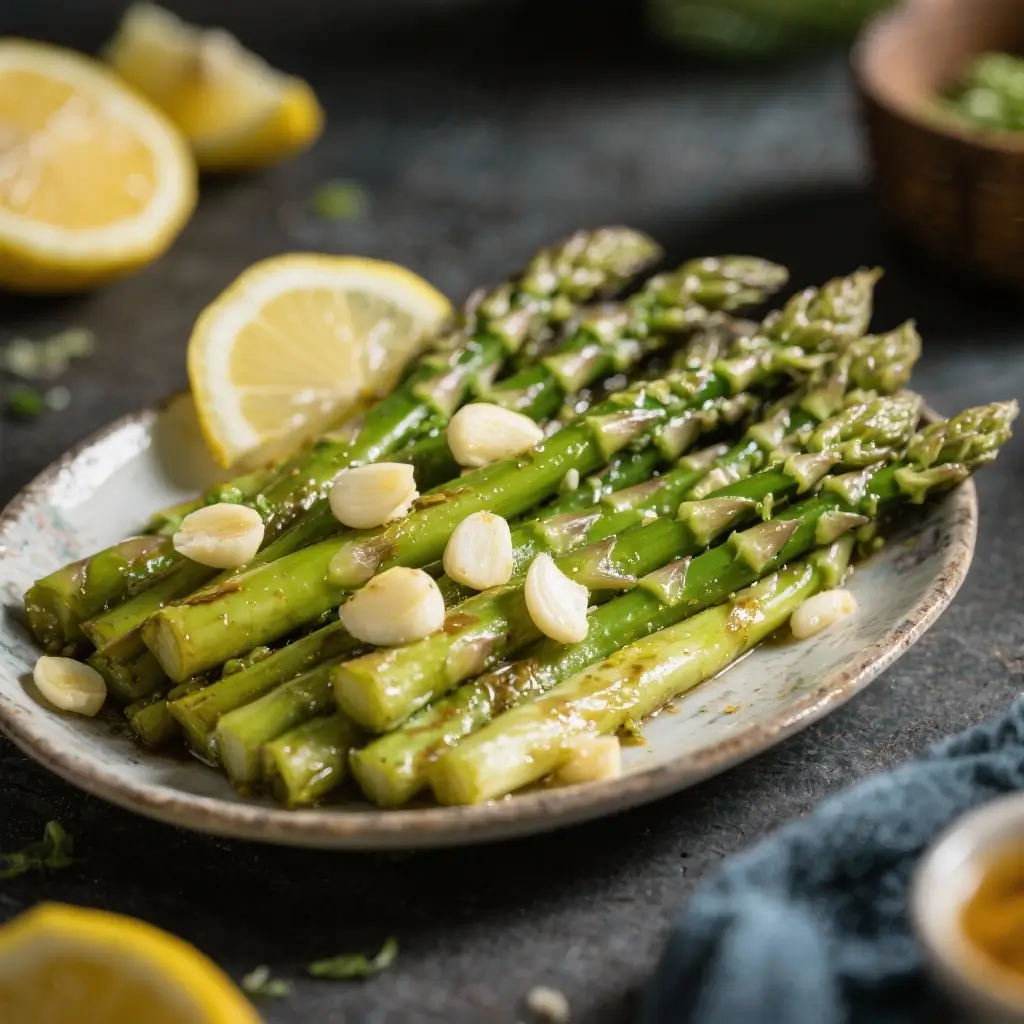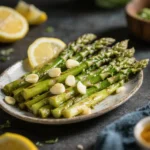Lemon Garlic Asparagus: A Zesty, Healthy Delight for Every Palate
There’s something undeniably elegant and satisfying about a perfectly prepared plate of lemon garlic asparagus. Crisp-tender spears infused with the bright tang of lemon, the aromatic punch of fresh garlic, and a hint of olive oil create a side dish that’s both simple and sophisticated. Whether you’re preparing a weeknight dinner or an elaborate holiday spread, this vegetable shines with versatility and flavor. Packed with nutrients, quick to make, and endlessly customizable, lemon garlic asparagus is a culinary gem that deserves a permanent spot in your recipe repertoire.
The History of Asparagus and Its Culinary Evolution
Asparagus has been cherished for thousands of years, dating back to ancient civilizations such as Egypt, Greece, and Rome. The Greeks considered it a medicinal plant, while the Romans elevated its status by cultivating it extensively and even creating special storage methods to enjoy it year-round. The word “asparagus” comes from the Greek asparagos, meaning “sprout” or “shoot,” reflecting its tender nature.
In Europe, particularly in France, Germany, and England, asparagus became a symbol of springtime luxury during the 17th and 18th centuries. French chefs were among the first to incorporate citrus and herbs into asparagus dishes, setting the foundation for modern preparations like lemon garlic asparagus. The use of garlic can be traced across Mediterranean cuisines, where it was valued not only for its flavor but also for its health benefits.
When asparagus arrived in North America, it quickly gained popularity, especially in regions with cooler climates ideal for cultivation—such as Michigan, Washington, and California. Over time, home cooks began blending Old World techniques with New World ingredients, leading to the creation of accessible, flavorful recipes like lemon garlic asparagus. Today, it stands as a staple on restaurant menus and family dinner tables alike, embodying the harmony between simplicity and gourmet flair.
Ingredients Breakdown: What Makes This Dish Shine
The beauty of lemon garlic asparagus lies in its minimal yet powerful ingredient list. Each component plays a vital role in building layers of flavor, texture, and nutrition:
- Fresh Asparagus: The star of the dish. Look for firm, bright green stalks with tightly closed tips. Thicker spears offer a meatier bite, while thinner ones cook faster and are more delicate.
- Fresh Garlic: Adds a pungent, savory depth. When sautéed gently, garlic becomes sweet and aromatic without being overpowering.
- Lemon: Both the zest and juice contribute a vibrant acidity that cuts through richness and enhances freshness. Lemon zest contains essential oils that intensify flavor.
- Olive Oil: High-quality extra virgin olive oil acts as the cooking medium and adds heart-healthy monounsaturated fats along with a fruity, peppery note.
- Salt and Black Pepper: Essential seasonings that balance and elevate all other flavors.
- Optional Additions: Red pepper flakes for heat, grated Parmesan for umami, chopped herbs (like parsley, thyme, or basil), or toasted almonds for crunch.
Together, these ingredients form a symphony of taste and aroma, turning a humble vegetable into a gourmet experience.
Step-by-Step Recipe: How to Make Perfect Lemon Garlic Asparagus
Follow this detailed guide to achieve restaurant-quality results at home—tender-crisp asparagus with bold lemon and garlic notes every time.
- Prepare the Asparagus: Rinse 1 pound of asparagus under cold water. Hold each spear near the base and bend it until it snaps naturally—the tough woody end will break off cleanly. Alternatively, trim about 1–2 inches from the bottom using a knife. Cut remaining spears into 2-inch pieces if desired, or leave whole for an elegant presentation.
- Prep the Aromatics: Mince 3–4 cloves of garlic (adjust to taste). Zest one lemon before juicing it—you’ll need about 2 tablespoons of juice and 1 teaspoon of zest.
- Heat the Pan: Place a large skillet over medium heat. Add 2 tablespoons of extra virgin olive oil and let it warm until shimmering but not smoking (about 1 minute).
- Sauté the Garlic: Add minced garlic to the hot oil. Stir constantly for 30–60 seconds until fragrant and just beginning to turn golden. Be careful not to burn it, as burnt garlic turns bitter.
- Add the Asparagus: Toss in the trimmed asparagus spears in a single layer if possible. Season immediately with ½ teaspoon salt and ¼ teaspoon freshly ground black pepper.
- Cook Until Tender-Crisp: Sauté for 5–7 minutes, stirring occasionally. For thicker spears, cover the pan with a lid for the first few minutes to steam them slightly, then uncover to finish browning. Cook until the asparagus is bright green and tender when pierced with a fork, but still offers slight resistance (al dente).
- Finish with Lemon: Remove the pan from heat. Drizzle with fresh lemon juice and sprinkle lemon zest over the top. Toss well to coat evenly.
- Optional Enhancements: Stir in 1 tablespoon of unsalted butter for richness, or sprinkle with 2 tablespoons of grated Parmesan cheese and chopped fresh parsley.
- Serve Immediately: Transfer to a serving platter or individual plates. Best enjoyed hot or warm.
Tips for Success: Mastering the Art of Lemon Garlic Asparagus
- Don’t Overcook: Overcooked asparagus turns mushy and loses its vibrant color. Aim for crisp-tender texture—this preserves both mouthfeel and nutrients.
- Use Fresh Ingredients: Bottled lemon juice and powdered garlic simply can’t match the brightness of fresh lemon and raw garlic. Always opt for fresh when possible.
- Uniform Cutting: Try to cut asparagus spears to similar thicknesses so they cook evenly. If mixing thick and thin spears, add the thinner ones later.
- Garlic Timing: Adding garlic too early or cooking it too long causes bitterness. Sauté just until golden, then proceed.
- Boost Flavor with Zest: Lemon zest packs intense citrus flavor without added liquid. Use a microplane grater for fine, even strips.
- Rest Before Serving: Letting the dish sit for 1–2 minutes after tossing with lemon allows flavors to meld beautifully.
- Batch Cooking Tip: If making a large quantity, cook in batches to avoid overcrowding the pan, which leads to steaming instead of sautéing.
Variations and Customizations: Making It Your Own
Lemon garlic asparagus is incredibly adaptable. Here are some creative twists to suit different tastes and dietary needs:
- Vegan Version: Skip dairy additions. Use nutritional yeast instead of Parmesan for a cheesy flavor.
- Keto-Friendly: Naturally low in carbs, this dish fits perfectly into a ketogenic lifestyle. Boost fat content with a drizzle of avocado oil or addition of sliced avocado on top.
- Gluten-Free: All ingredients are naturally gluten-free. Just ensure any optional add-ins (like flavored salts) are certified GF.
- Mediterranean Style: Add sun-dried tomatoes, Kalamata olives, crumbled feta, and oregano for a Greek-inspired twist.
- Asian Fusion: Swap lemon for yuzu or rice vinegar, add ginger, soy sauce, and sesame oil, and garnish with sesame seeds.
- Creamy Lemon Garlic Asparagus: Stir in 2–3 tablespoons of heavy cream, coconut milk, or Greek yogurt at the end for a silky sauce.
- Grilled Asparagus: Toss spears in olive oil, garlic, salt, and pepper, then grill over medium-high heat for 6–8 minutes, turning once. Finish with lemon juice and zest post-grill.
- Bacon-Wrapped Asparagus: Wrap thicker spears with bacon slices before roasting or grilling. Top with lemon-garlic glaze after cooking.
- Roasted Lemon Garlic Asparagus: Preheat oven to 425°F (220°C). Toss asparagus with oil, garlic, salt, and pepper. Roast on a baking sheet for 12–15 minutes. Finish with lemon juice and zest.
- Sheet Pan Addition: Roast alongside chicken, salmon, or potatoes for a complete one-pan meal.
Health Considerations and Nutritional Value
Lemon garlic asparagus isn’t just delicious—it’s a powerhouse of nutrition. Incorporating this dish into your diet supports overall wellness in multiple ways.
Nutrient Profile (Per Serving, Approx. 1 cup cooked):
- Calories: ~40 kcal
- Protein: 3g
- Fat: 2.5g (mostly healthy monounsaturated from olive oil)
- Carbohydrates: 5g
- Fiber: 3g (supports digestion and gut health)
- Vitamin K: Over 100% DV (essential for blood clotting and bone health)
- Folate (Vitamin B9): ~34% DV (crucial for cell division and pregnancy health)
- Vitamin C: ~20% DV (antioxidant that boosts immunity)
- Vitamin A: Moderate amount (supports vision and skin health)
- Potassium: Helps regulate blood pressure
- Antioxidants: Glutathione, flavonoids, and polyphenols help combat oxidative stress
Key Health Benefits:
- Supports Heart Health: Folate helps reduce homocysteine levels, a risk factor for heart disease. Olive oil contributes heart-healthy fats.
- Aids Digestion: High fiber content promotes regular bowel movements and feeds beneficial gut bacteria.
- Promotes Detoxification: Asparagus contains glutathione, a potent antioxidant that assists liver detox pathways.
- Bone Strength: Rich in vitamin K, which improves calcium absorption and reduces urinary calcium loss.
- Natural Diuretic: Asparagus has mild diuretic properties due to asparagine, an amino acid that may help reduce bloating and water retention.
- Immune Support: Vitamin C and antioxidants strengthen immune defenses and reduce inflammation.
Dietary Notes:
- Suitable for vegetarian, vegan (if no animal products added), paleo, Whole30 (without cheese/butter), keto (low-carb version), and gluten-free diets.
- Low glycemic index—ideal for blood sugar management.
- Contains purines, so those with gout may want to consume in moderation.
- Lemon juice enhances iron absorption from plant foods, making this dish a great companion to legumes or leafy greens.
Full Ingredient List
- 1 pound fresh asparagus
- 2 tablespoons extra virgin olive oil
- 3–4 cloves garlic, minced
- Zest of 1 lemon
- 2 tablespoons fresh lemon juice (from 1 medium lemon)
- ½ teaspoon sea salt (or to taste)
- ¼ teaspoon freshly ground black pepper
Optional Add-Ins: 1 tablespoon butter, 2 tbsp grated Parmesan, 1/4 tsp red pepper flakes, 2 tbsp chopped fresh parsley, 2 tbsp toasted slivered almonds.
Detailed Directions
- Wash asparagus thoroughly under running water. Snap off or cut the woody ends.
- Pat dry with a clean towel. Set aside.
- Using a zester or fine grater, remove the yellow outer peel of the lemon (avoid white pith).
- Roll the lemon slightly on the counter and squeeze to extract juice (~2 tbsp).
- Heat olive oil in a large non-stick or stainless steel skillet over medium heat.
- Add minced garlic; stir constantly for 30–60 seconds until fragrant and lightly golden.
- Add asparagus spears in a single layer. Season with salt and pepper.
- Sauté uncovered for 4 minutes. If stems are thick, cover pan briefly to accelerate softening.
- Stir and continue cooking 2–4 minutes more until asparagus is bright green and tender-crisp.
- Remove from heat. Immediately pour lemon juice over the top and sprinkle lemon zest.
- Toss gently to combine. Taste and adjust seasoning if needed.
- If using, stir in butter until melted or sprinkle with Parmesan and herbs.
- Serve warm as a side dish with grilled fish, chicken, pasta, or quinoa.
Frequently Asked Questions (FAQ)
Q: Can I use frozen asparagus?
A: While possible, fresh asparagus yields far superior texture and flavor. Frozen asparagus tends to become soggy when thawed and cooked. If you must use frozen, partially thaw and pat dry before sautéing, but expect softer results.
Q: How do I store leftovers?
A: Store cooled leftovers in an airtight container in the refrigerator for up to 3 days. Reheat gently in a skillet over low heat to preserve texture—microwaving may make it mushy.
Q: Why did my garlic burn?
A: Garlic burns easily at high temperatures. Always cook over medium or medium-low heat and stir frequently. If burning occurs, discard and start again—burnt garlic ruins the entire dish.
Q: Can I prep this ahead of time?
A: Yes! Trim asparagus and mince garlic up to 24 hours in advance. Store separately in sealed containers in the fridge. Zest and juice lemon the day of cooking for maximum freshness.
Q: Is lemon garlic asparagus good for weight loss?
A: Absolutely. Low in calories, high in fiber, and rich in nutrients, it’s a filling, guilt-free side that complements any weight-conscious meal plan.
Q: What protein pairs best with this dish?
A: Grilled salmon, lemon herb chicken, seared scallops, roasted turkey, tofu, or shrimp all pair beautifully. The citrus-garlic profile complements both light and rich proteins.
Q: Can I make this in the air fryer?
A: Yes! Toss asparagus with oil, garlic, salt, and pepper. Air fry at 375°F (190°C) for 8–10 minutes, shaking halfway. Finish with lemon juice and zest.
Q: Why does asparagus make my urine smell?
A: Asparagus contains asparagusic acid, which breaks down into sulfur-containing compounds during digestion. These give urine a distinctive odor—harmless and temporary. Not everyone can detect the smell due to genetic differences.
Summary
Lemon garlic asparagus is a quick, nutritious, and dazzlingly flavorful side dish that transforms a simple vegetable into a gourmet favorite. With its vibrant color, crisp texture, and zesty aroma, it brings elegance to any table.
Packed with vitamins, fiber, and heart-healthy fats, this recipe proves that eating well can be both delicious and effortless—perfect for busy nights and special occasions alike.










